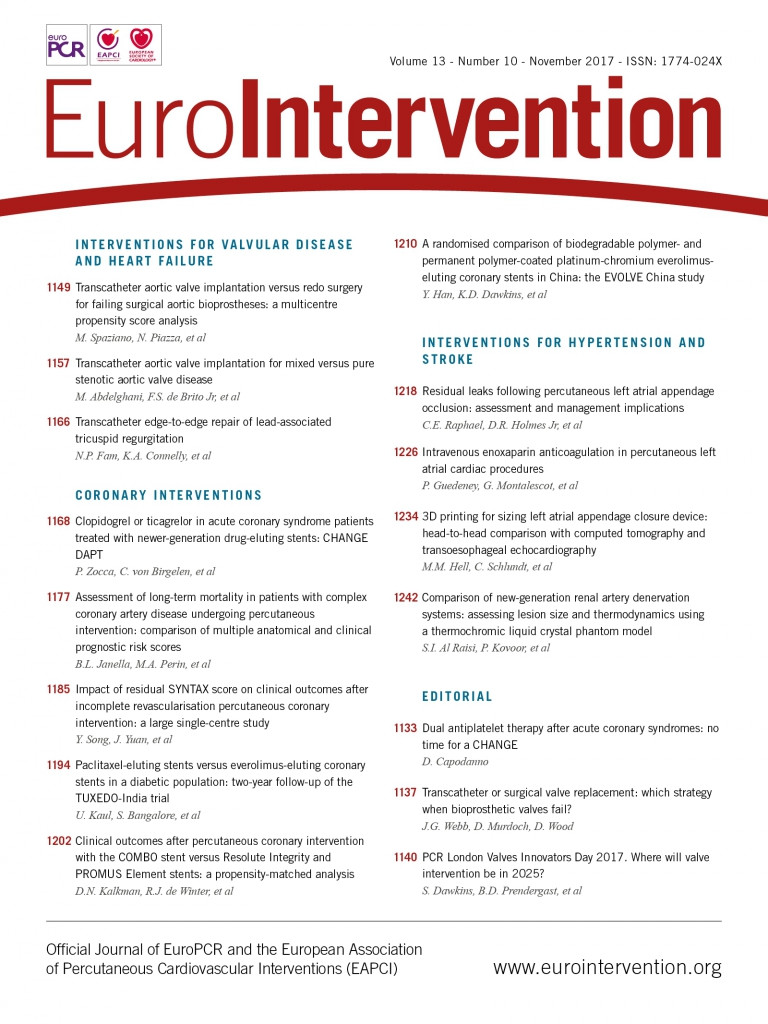
In patients with an acute coronary syndrome (ACS), one year of dual antiplatelet therapy (DAPT) with low-dose aspirin and a platelet P2Y12 receptor inhibitor is the recommended strategy for pharmacological prevention of recurring atherothrombotic events1. Based on guidelines, prasugrel and ticagrelor are the preferred options for combination therapy with aspirin, owing to the results of two international trials unequivocally demonstrating a reduction in the composite of cardiac death, myocardial infarction and stroke compared with clopidogrel2,3. Now, a study from Zocca and colleagues questions the role of ticagrelor as a first-line antiplatelet option in patients with ACS undergoing percutaneous coronary intervention (PCI)4.
The observational study, named CHANGE DAPT, compared contemporary patients with ACS who received drug-eluting stents (DES) in two consecutive phases – from December 2012 to May 2014 (clopidogrel period, N=1,009), and from May 2014 to August 2015 (ticagrelor period, N=1,053). The primary endpoint of combined death, myocardial infarction (any), stroke or major bleeding was lower in the clopidogrel than in the ticagrelor period (5.1% vs. 7.8%, p=0.02), driven by (but not limited to) a significantly lower incidence of major bleeding with no statistically significant difference in other individual endpoints or in the composite of cardiac death, myocardial infarction and stroke (3.7% vs. 4.7%, p=0.27). These findings were substantially replicated in propensity score-adjusted and “as-treated” analyses. In a landmark analysis, ticagrelor was associated with significantly more major bleeding than clopidogrel both at 30 days and between 30 days and one year.
The busy reader could hastily label this study as “non-randomised” and therefore be tempted to escape tout court from its conclusions. However, by externally validating the conclusions of randomised trials and generating hypotheses for subsequent investigations, observational studies have a role in the hierarchy of evidence. Because a study is only as good as its methodology, no matter whether randomised or non-randomised, the scrupulous work of Zocca and colleagues deserves attention and critical thinking. In fact, when checking CHANGE DAPT against quality criteria for observational cohorts and cross-sectional studies, a “yes” can be flagged on a number of domains: the study population was well defined, the entry criteria were broad and inclusive, sample size justification was given, outcome measures were implemented consistently across study participants (with a commendable 99.3% follow-up completion), and potential confounding variables were captured and adjusted statistically for their impact on the relationship between DAPT regimen and outcomes.
On the other hand, virtually all studies have limitations and CHANGE DAPT is no exception. First, with respect to data completeness, we lack some information on admission and pre-PCI medications (including the proportion of patients pre-treated with antiplatelet drugs), as well as important angiographic and procedural variables. This is not immune from consequences because no collection of those variables means no chance for statistical adjustment in case of hidden discrepancies between the clopidogrel and ticagrelor groups. Second, the study used a broad definition of myocardial infarction and did not distinguish periprocedural from spontaneous events, although it is fair to admit that this criticism becomes relative in view of the very low event rate reported in the study. Third, the reader should consider the non-trivial 15% rate of crossover between intended DAPT regimens at one year, which complicates the study interpretation. Fourth, another potential caveat is the recruitment of subjects from similar populations but different time periods. No major breakthrough in device technology occurred during the recruitment period to justify substantial differences in the way patients received treatment for ACS other than antiplatelet therapy. We can also acknowledge that patient recruitment and treatment allocation in separate short consecutive periods have the theoretical advantage of reducing treatment bias to some extent. Still, some differences in patients recruited in the clopidogrel and ticagrelor periods remained and were notable: for example, patients treated in the later period were more likely to undergo radial PCI, less likely to receive glycoprotein IIb/IIIa inhibitors and more likely to receive proton pump inhibitors. In CHANGE DAPT, these characteristics worked in favour of ticagrelor, but the drug finally caused more bleeding than clopidogrel: this consideration reinforces the message of the study rather than really detracting from it. Unfortunately, the elephant in the room is the lack of randomisation, introducing a number of unidentified confounders that are difficult to control adequately, even using the most sophisticated statistical approach.
A key methodological aspect of the CHANGE DAPT study is the focus on a net composite of ischaemic and bleeding complications (net adverse clinical and cerebral events [NACCE]). This approach is frequently adopted in investigator-driven studies of antithrombotic strategies to keep the sample size estimation to a reasonable extent, but entails a number of problems in interpretation. Also, interestingly, the study is built around a non-inferiority hypothesis as is more typically (and perhaps more properly) seen in randomised studies. Even so, the non-inferiority margin of 2.7% was chosen based on data from low-risk PCI cohorts as the one from CHANGE DAPT turned out to be. The study interpretation with respect to non-inferiority finally proved inconclusive because of the wide confidence interval for the risk difference in NACCE between ticagrelor and clopidogrel, including both zero and the margin of non-inferiority, thereby implying a lack of precision for correctly interpreting the study results.
Bearing in mind all of the above-mentioned limitations, the closest reference in the literature to put the results of CHANGE DAPT into perspective is the PLATO trial, which also reported outcomes of ticagrelor and clopidogrel at one year, but in a randomised fashion3. At variance with CHANGE DAPT, PLATO included not only ACS patients managed invasively but also those undergoing conservative management or coronary artery bypass graft (CABG). In a post hoc analysis of PLATO restricted to 13,408 ACS patients undergoing invasive management (with PCI performed in about 77%), the one-year composite of cardiac death, myocardial infarction and stroke occurred in 9% of patients randomised to ticagrelor and 10.7% of patients randomised to clopidogrel (p=0.0025)5. These figures are higher than those reported in CHANGE DAPT, implying potential differences in the latter due to ascertainment bias and/or dissimilarities in endpoint definition and patient population (i.e., higher risk in PLATO which mandated additional criteria of atherothrombotic risk on top of ACS presentation; use of second-generation DES in CHANGE DAPT). Of note, a total of 1,237 cardiac death, myocardial infarction or stroke events were counted in PLATO and only 86 in CHANGE DAPT. This implies a substantial disparity in the power of the two studies for detecting significant differences. As such, CHANGE DAPT cannot confute the outcomes of PLATO with respect to efficacy, being also at variance with the conclusions of a much larger (N=45,073) registry from the SWEDEHEART collaboration6. With respect to safety, the results of CHANGE DAPT and PLATO were also quite different. Compared with clopidogrel, ticagrelor increased major bleeding (BARC class 3 or 5 and/or all [CABG- and non-CABG-related] TIMI major bleeding) from 1.2% to 2.7% in CHANGE DAPT (adjusted p-value=0.01), based on 40 events, while the rates of TIMI major bleeding were again substantially higher and identical between ticagrelor and clopidogrel (7.9%) in PLATO, based on 950 events. With 24-fold fewer events than the post hoc analysis of PLATO leading to the opposite conclusions, we cannot rule out the bleeding findings of CHANGE DAPT as also representing the play of chance.
Finally, by displaying a difference in NACCE that becomes significant only between 30 days and one year, the results of CHANGE DAPT mirror those of TOPIC, a recent small trial of 646 ACS patients that reported lower NACCE at one year with de-escalation to clopidogrel after an initial 30-day term with prasugrel or ticagrelor7. This strategy is sometimes embraced in clinical practice, being perceived as safer than the standard one-year term of prasugrel or ticagrelor recommended by guidelines, particularly in categories of patients at high risk of bleeding. The rationale for this approach rests in the belief that prasugrel and ticagrelor will exert their maximal benefit over clopidogrel in the early phase, which is actually not true when looking at landmark analyses of pivotal trials suggesting that the benefit continues in the long term2,3. There is therefore little evidence at present to support a change towards the approach of “downgrading” DAPT in clinical practice, although the results of TOPIC and CHANGE DAPT are intriguing and hypothesis-generating. In further testing of this concept, the efficacy of a stepwise antiplatelet therapy regimen is the objective of the upcoming GLOBAL-LEADERS trial (NCT01813435), a large clinical trial of 16,000 all-comers patients undergoing PCI (also including ACS), aimed at investigating whether switching from DAPT to ticagrelor alone at 30 days (another “less is more” approach) significantly reduces the composite of death and myocardial infarction as compared with conventional DAPT.

